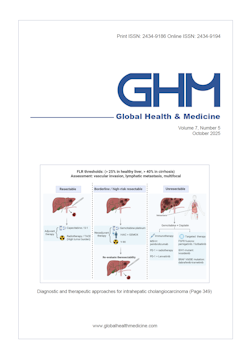Global Health & Medicine 2024;6(2):124-131.
Coronary artery stenosis in Japanese people living with HIV-1 with or without haemophilia
Nagai R, Ogata M, Kubota S, Yamamoto M, Uemura H, Tanuma J, Gatanaga H, Hara H, Oka S, Hiroi Y
An extremely high prevalence (12.2%) of moderate-to-severe coronary artery stenosis (CAS) was documented in asymptomatic Japanese haemophiliacs living with HIV-1 (JHLH) in our previous study. The cause of this phenomenon remains unknown. We conducted the CAS screening in people living with HIV-1 without haemophilia (PLWH without haemophilia) to compare the prevalence of CAS in JHLH and PLWH without haemophilia and to identify the risk factors including inflammation markers. Ninety-seven age-matched male PLWH without haemophilia who consulted our outpatient clinic between June and July 2021 were randomly selected, and 69 patients who provided informed consent were screened for CAS using coronary computed tomography angiography (CCTA). The number of JHLH cases was 62 in this study. The prevalence of moderate (> 50%) to severe (> 75%) CAS was significantly higher in JHLH [14/57 (24.6%) vs. 6/69 (8.7%), p = 0.015], and the ratio of CAS requiring urgent interventions was significantly higher [7 (12.3%) vs. 1 (1.4%), p = 0.013] in JHLH than in PLWH without haemophilia. Among the inflammatory markers, serum titres of intercellular adhesion molecule-1 (p < 0.05) and interleukin-6 (p < 0.05) in JHLH were significantly higher than those in PLWH without haemophilia. Although some patient demographics were different in the age-matched study, it might be possible to speculate that intravascular inflammation might promote CAS in JHLH.
DOI: 10.35772/ghm.2023.01101







